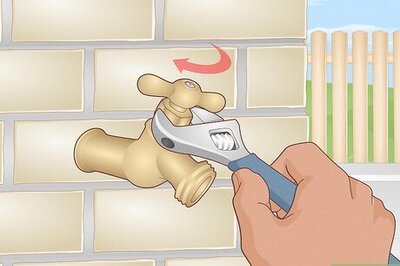
views
How to Stop Sound Coming from Both TV and Soundbar
Change the TV audio output setting to your soundbar. When you first connect your soundbar, the audio output device may not automatically change. Open your TVs menu and open the Sound settings. Look for an option labeled Audio Output, Output Device, or something similar. Change the output device to the connection you’re using with your soundbar, such as HDMI, Optical, or Wi-Fi. If you still hear sound coming from your TV speakers, look in the sound settings for an option that switches your TV speakers on or off.
Connect your TV and soundbar with an HDMI cable. Paris recommends using the designated audio return channel (ARC) or eARC HDMI ports when you connect your TV to a soundbar. Using only an optical cable causes sound to come from both your TV and soundbar. Double-check that you have the HDMI selected as your audio output device in your TV’s settings. Paris notes that using the ARC or eARC HDMI port allows you to use your TV’s remote to control the volume instead of the soundbar remote.
Reset your TV and soundbar. If you’re still encountering issues with your TV and soundbar, a quick reset can fix the hardware settings. Just keep in mind you may lose any login info or saved features on your devices. Open the settings menu on your TV and look for a Reset option to restore it to factory settings. Check the manual for your soundbar or look up the model online to find the specific reset instructions.
How to Get Sound from TV and Soundbar
Turn on the TV speakers in the audio settings. Go into your TV’s menu and locate the Sound or Audio settings. Locate the option labeled TV Speakers and switch it on. Turn up the volume of your TV speakers with your TV’s remote, and control the soundbar with its remote. This may only work if your soundbar is connected with an optical cable. Most times, connecting to a soundbar with HDMI or Wi-Fi overrides the TV speakers.
Check the sound settings for a “TV + Soundbar” option. Open your TV’s menu and select the Sound or Audio settings. Look for the option labeled Output Device or Audio Output. Check the list for the option labeled TV+Soundbar so audio comes out from both speakers. Not all TVs will have this option, so it may not be possible to use your soundbar and speakers. If you’re using Samsung devices, you may be able to use the Q-Symphony feature on compatible devices to mimic surround sound. Connect your TV to your soundbar, and the “TV+Soundbar” option will appear on your TV’s sound output settings.
Troubleshooting Other Soundbar Issues
No sound from soundbar Check the Audio settings on your TV first to make sure that you’ve selected the soundbar as your output device. If that doesn’t fix the issue, check that you have the matching input setting selected on your soundbar. If there’s still no sound, turn off your TV and soundbar. Start your TV, wait about 10 seconds, and turn on your soundbar. If you still can’t hear anything from your soundbar, try using a different cord or connection type to connect it to your TV.
Delayed audio from soundbarIf you notice the audio delay on a single app or source, like a game console, then try restarting the app or device. If that doesn’t work, then try replacing the cord connecting your TV and soundbar. Using the ARC or eARC HDMI ports may also solve the issue. If nothing else works, Paris says to check your TV’s audio settings for an Audio Delay or Lip Sync setting to manually sync the audio and video.
TV remote doesn’t work with soundbar Paris mentions using the ARC or eARC HDMI ports allows you to control the volume with your TV remote, so double-check your soundbar connections. Older TVs may not have ARC or eARC HDMI ports, so you will not be able to use your TV remote to control the soundbar volume. Use the remote that came with your soundbar instead.















Comments
0 comment